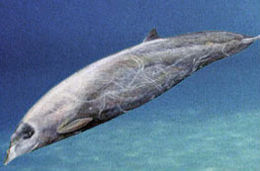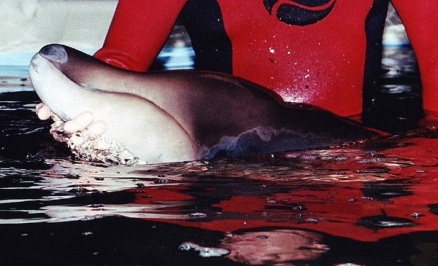Stejneger's beaked whale
Stejneger's beaked whale (scientific name: Mesoplodon stejnegeri) is one of 21 species of beaked whales (Hyperoodontidae or Ziphiidae), medium-sized whales with distinctive, long and narrow beaks and dorsal fins set far back on their bodies. They are marine mammals within the order of cetaceans.
 Stejneger's beaked whale. Source: NOAA Stejneger's beaked whale. Source: NOAA
|
 Size comparison of an average human against Stejneger's beaked whale. Source: Chris Huh Size comparison of an average human against Stejneger's beaked whale. Source: Chris Huh
|
|
Conservation Status: |
|
Scientific Classification Kingdom: Animalia |
|
Common Names: |
Thirty-one of the 48 sightings of Stejnegers beaked whale have come from Alaskan waters. It is suspected this species favors deep waters, including the Aleutian Trench and the Aleutian Basin, which is some 3500 meters deep, rather than the shallow waters of the Bering Sea. The whales were seen traveling in groups of five to fifteen; some individuals were large and some were small. This species is also known as the Sabre-toothed beaked whale, hinting at the shape of the adult male's teeth.
Contents
Physical Description
Stejneger's beaked whale ranges in length from three to seven meters, although they are generally longer than 5.3 m. Females are normally longer than males, and the crania of females are larger than those of males.
Both sexes are uniformly gray to black, with light pale countershading ventrally, although males tend to be more uniformly dark.
Stejneger's beaked whale is distinguished from other Mesoplodons by tooth shape and position. Members of this species have two large, exposed, tusk-like teeth on the lower jaw (Nowak 1999). These teeth are also distinctively larger in males.
Scarring, which is present on most Stejneger's beaked whale, results from intraspecific fighting over mates, and is inflicted by the teeth while the mouth is closed (Nowak, 1999; Ridgway and Harrison, 1989).
Other Physical Features: Endothermic; Homoiothermic; Bilateral symmetry
Sexual Dimorphism: Female larger; Male more colorful; Ornamentation
Behaviour
These beaked whales are deep divers. They swim at three to four knots on average, with maximum speeds reaching 6 knots.
This species usually swims in pods containing two to six individuals, although groups of five to fifteen individuals have been observed. Within these social pods, individual whales vary in size, sex, and age. They swim abreast in the pods, touching one another, and they surface and submerge simultaneously.
A common pattern of several shallow dives followed by a longer dive of about 10 to 15 minutes has been noted.
Also while in these pods, members of this species take 2 to 3 low blows in unison, which are proceeded by sounds described as "roars, lowing and sobbing groans." (Loughlin and Perez, 13 December 1985)
Key Behaviors: natatorial; diurnal; motile; nomadic; social
Reproduction
Little recorded information is known about the reproduction of Stejneger's beaked whale, although it is speculated that litter size is one and parturition occurs in the spring and summer. (Loughlin and Perez, 13 December 1985)
Key Reproductive Features: Iteroparous; Seasonal breeding; Gonochoric/gonochoristic/dioecious (sexes separate); Sexual; Fertilization; Viviparous
Although parental investment in this species has not been documented, because these animals are mammals we can infer that females provide a great deal of parental care. They are likely to provide their young with protection as well as food, in the form of milk, until the calves are able to care for themselves.
Distribution and MovementsFile:Distribution of Stejneger
Stejneger's beaked whale ranges from the Bering Sea to California and Japan, inhabiting only the cool temperate waters of the Northern Pacific Ocean. (Nowak, 1999)
Habitat
Stejneger's beaked whales, inhabit the deep waters of the ocean far from the shorelines. These animals are rarely seen at sea. They prefer a habitat with cool water.
Stejneger's beaked whale has been observed living sympatrically with Hubb's beaked whale where the ranges of the two species overlap off the coast of northern Japan to Oregon and British Columbia. (Loughlin and Perez, 13 December 1985)
Habitat Regions: Temperate; Saltwater or marine
Aquatic Biomes: Pelagic
Feeding Habits
Stejneger's beaked whale feeds primarily on deep-water squid. The diet includes cephalopods, mollusks and fish.
A school of salmon was observed being chased by Stejneger's beaked whale off the coast of Japan, and this species is sometimes trapped in salmon driftnets. (Loughlin and Perez, 1985)
Economic Importance for Humans
The meat of Stejneger's beaked whale is considered palatable when cooked, but the Makah Indians of Washington reported cases of diarrhea after eating the blubber and flesh. Commercial fisheries, primarily in Japan, take a number of M. stejnegeri yearly. (Loughlin and Perez, 1985)
Threats and Conservation Status
The IUCN Red List reports:
Stejneger's beaked whales were hunted in a Japanese fishery, along with Cuvier’s beaked whales. They are not presently the main targets of any hunt.
In the past, some individuals were taken in the Japanese salmon driftnet fishery in the Sea of Japan and in driftnets off the west coast of North America. Entanglement in fishing gear, especially gillnets in deep water, is probably the most significant threat.
This species, like other beaked whales, is likely to be vulnerable to loud anthropogenic sounds, such as those generated by navy sonar and seismic exploration (Cox et al. 2006).
As a cold water species, Stejneger’s beaked whale is a cold water species Its range could be affected by any change in ocean temperature distribution, but no data exists to support concern over this issue (Learmonth et al. 2006). Evidence from stranded individuals of several similar species indicates that they have swallowed discarded plastic items, which may eventually lead to death (e.g. Scott et al. 2001); this species may also be at risk.
These whales are a conservation concern. They are listed as Appendix II by CITES, and Data deficient by IUCN.
IUCN Red List: Data Deficient
US Federal List: No special status
CITES: Appendix II
References
- "Mesoplodon stejnegeri True, 1885". Encyclopedia of Life. Accessed 12 May 2011.
- Csomos, R. 2000. "Mesoplodon stejnegeri" (On-line), Animal Diversity Web. Accessed May 12, 2011.
- Taylor, B.L., Baird, R., Barlow, J., Dawson, S.M., Ford, J., Mead, J.G., Notarbartolo di Sciara, G., Wade, P. & Pitman, R.L. 2008. Mesoplodon stejnegeri. In: IUCN 2010. IUCN Red List of Threatened Species. Version 2010.4. . Downloaded on 15 May 2011.
- Balcomb, K. C. and Claridge, D. E. 2001. A mass stranding of cetaceans caused by naval sonar in the Bahamas. Bahamas Journal of Science 8(2): 2-12.
- Banks, R. C., R. W. McDiarmid, A. L. Gardner, and W. C. Starnes. 2003. Checklist of Vertebrates of the United States, the U.S. Territories, and Canada
- Banks, R. C., R. W. McDiarmid, and A. L. Gardner. 1987. Checklist of Vertebrates of the United States, the U.S. Territories, and Canada. Resource Publication, no. 166. 79
- Cox, T. M., Ragen, T. J., Read, A. J., Vos, E., Baird, R. W., Balcomb, K., Barlow, J., Caldwell, J., Cranford, T., Crum, L., D'Amico, A., D'Spain, A., Fernández, J., Finneran, J., Gentry, R., Gerth, W., Gulland, F., Hildebrand, J., Houser, D., Hullar, T., Jepson, P. D., Ketten, D., Macleod, C. D., Miller, P., Moore, S., Mountain, D., Palka, D., Ponganis, P., Rommel, S., Rowles, T., Taylor, B., Tyack, P., Wartzok, D., Gisiner, R., Mead, J. and Benner, L. 2006. Understanding the impacts of anthropogenic sound on beaked whales. Journal of Cetacean Research and Management 7(3): 177-187.
- Fernández, A., Edwards, J. F., Rodriguez, F., Espinosa, A., De Los Monteros, Herraez, P., Castro, P., Jaber, J. R., Martin, V. and Arebelo, M. 2005. "Gas and fat embolic syndrome" involving a mass stranding of beaked whales (family Ziphiidae) exposed to anthropogenic sonar signals. Veterinary Pathology 42: 446-457.
- Gomercic, H., Gomercic, M. D., Gomericic, T., Lucic, H., Dalebout, M., Galov, A., Skrtic, D., Curkovic, S., Vukovic, S. and Huber, D. 2006. Biological aspects of Cuvier's beaked whale (Ziphius cavirostris) recorded in the Croatian part of the Adriatic Sea. European Journal of Wildlife Research 52(3): 182-187.
- Houston, J. 1990. Status of Stejneger's beaked whale, Mesoplodon stejenegeri, in Canada. Canadian Field-Naturalist 104: 131-134.
- IUCN (2008) Cetacean update of the 2008 IUCN Red List of Threatened Species.
- Jefferson, T., S. Leatherwood, M. Webber. 1993. Marine Mammals of the World. Rome: United Nations Environment Programme.
- Jepson, P. D., Arebelo, M., Deaville, R., Patterson, I. A. P., Castro, P., Baker, J. R., Degollada, E., Ross, H. M., Herraez, P., Pocknell, A. M., Rodriguez, F., Howie, F. E., Espinosa, A., Reid, R. J., Jaber, J. R., Martin, V., Cunningham, A. A. and Fernandez, A. 2003. Gas-bubble lesions in stranded cetaceans. Nature 425: 575-576.
- Kakuda, T. and Yamada, T. K. 2001. Genetic variability of Stejneger's beaked whale (Mesoplodon stejnegeri) in the Sea of Japan based on mtDNA sequences. 14th Biennial Conference on the Biology of Marine Mammals. Vancouver, British Columbia, Canada.
- Learmonth, J. A., Macleod, C. D., Santos, M. B., Pierce, G. J., Crick, H. Q. P. and Robinson, R. A. 2006. Potential effects of climate change on marine mammals. Oceanography and Marine Biology: An Annual Review 44: 431-464.
- Loughlin, T. R. and Perez, M. A. 1985. Mesoplodon stejengeri. Mammalian Species 250: 1-6.
- Loughlin, T., M. Perez. 13 December 1985. Mesoplodon stejnegeri. Mammalian Species, No. 250: pp. 1-6.
- Loughlin, Thomas R., and Michael A. Perez. 1985. Mesoplodon stejnegeri. Mammalian Species, no. 250. 1-6
- Macleod, C. D., Perrin, W. F., Pitman, R. L., Barlow, J., Balance, L., D'amico, A., Gerrodette, T., Joyce, G., Mullin, K. D., Palka, D. L. and Waring, G. T. 2006. Known and inferred distributions of beaked whale species (Ziphiidae: Cetacea). Journal of Cetacean Research and Management 7(3): 271-286.
- Malakoff, D. 2002. Suit ties whale deaths to research cruise. Science 298: 722-723.
- Mead, J. G. 1989. Beaked whales of the genus Mesoplodon. In: S. H. Ridgway and R. Harrison (eds), Handbook of marine mammals, Vol. 4: River dolphins and the larger toothed whales, pp. 349-430. Academic Press.
- Mead, James G., and Robert L. Brownell, Jr. / Wilson, Don E., and DeeAnn M. Reeder, eds. 2005. Order Cetacea. Mammal Species of the World: A Taxonomic and Geographic Reference, 3rd ed., vol. 1. 723-743
- Nowak, R. 1999. Walker's Mammals of the World, 6th Edition. Baltimore and London: The Johns Hopkins University Press.
- Perrin, W. (2010). Mesoplodon stejnegeri True, 1885. In: Perrin, W.F. World Cetacea Database. Accessed through: Perrin, W.F. World Cetacea Database on 2011-05-05
- Rice, Dale W. 1998. Marine Mammals of the World: Systematics and Distribution. Special Publications of the Society for Marine Mammals, no. 4. ix + 231
- Ridgway, S., S. Harrison. 1989. Handbook of Marine Mammals, Volume 4: River Dolphins and the Larger Toothed Whales. New York: Academic Press.
- Scott, M. D., Hohn, A. A., Westgate, A. J., Nicolas, J. R., Whitaker, B. R. and Campbell, W. B. 2001. A note on the release and tracking of a rehabilitated pygmy sperm whale (Kogia breviceps). Journal of Cetacean Research and Management 3(1): 87-94.
- True, F.W., 1885. Contributions to the history of the Commander Islands. No. 5-Description of a new species of Mesoplodon, M. Stejnegeri, obtained by Dr. Leonard Stejneger, in Bering Island, 8:585. Proceedings of theU.S. National Museum, 8:584-585.
- UNESCO-IOC Register of Marine Organisms
- Wang, J. Y. and Yang, S. C. 2006. Unusual cetacean stranding events of Taiwan in 2004 and 2005. Journal of Cetacean Research and Management 8: 283-292.
- Wilson, Don E., and DeeAnn M. Reeder, eds. 1993. Mammal Species of the World: A Taxonomic and Geographic Reference, 2nd ed., 3rd printing. xviii + 1207
- Wilson, Don E., and F. Russell Cole. 2000. Common Names of Mammals of the World. xiv + 204
- Wilson, Don E., and Sue Ruff, eds. 1999. The Smithsonian Book of North American Mammals. xxv + 750
- Yamada, T. 1998. Stejneger's beaked whale, Mesoplodon stejnegeri, True 1885. In: Japan Fisheries Agency (ed.), Redbook Data on Aquatic Flora and Fauna, Part III. Aquatic Mammals, pp. 53-59. Japan Fisheries Resource Conservation Association.
- Yamada, T. K. 1997. Strandings of Cetacea to the coasts of the Sea of Japan - with special reference to Mesoplodon stejnegeri. IBI Reports 7: 9-19.
- Yamada, T. K., Kubodera, T., Nakamura, Y., Amano, M., Suzuki, M. and Shindo, J. 1995. Stomach contents of a stranded Mesoplodon stejnegeri (Ziphiidae). Nihonkai Cetology 5: 31-36.
